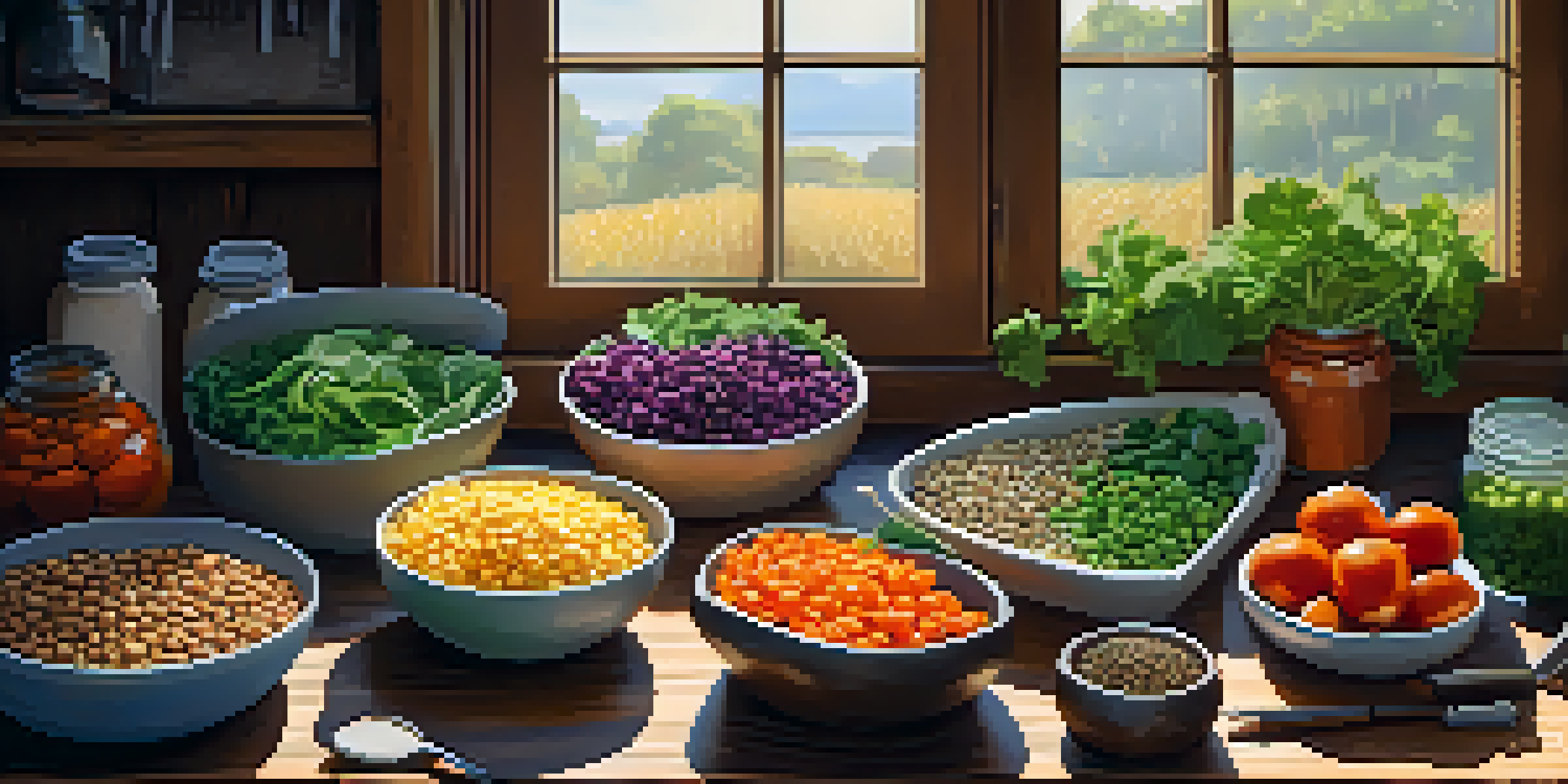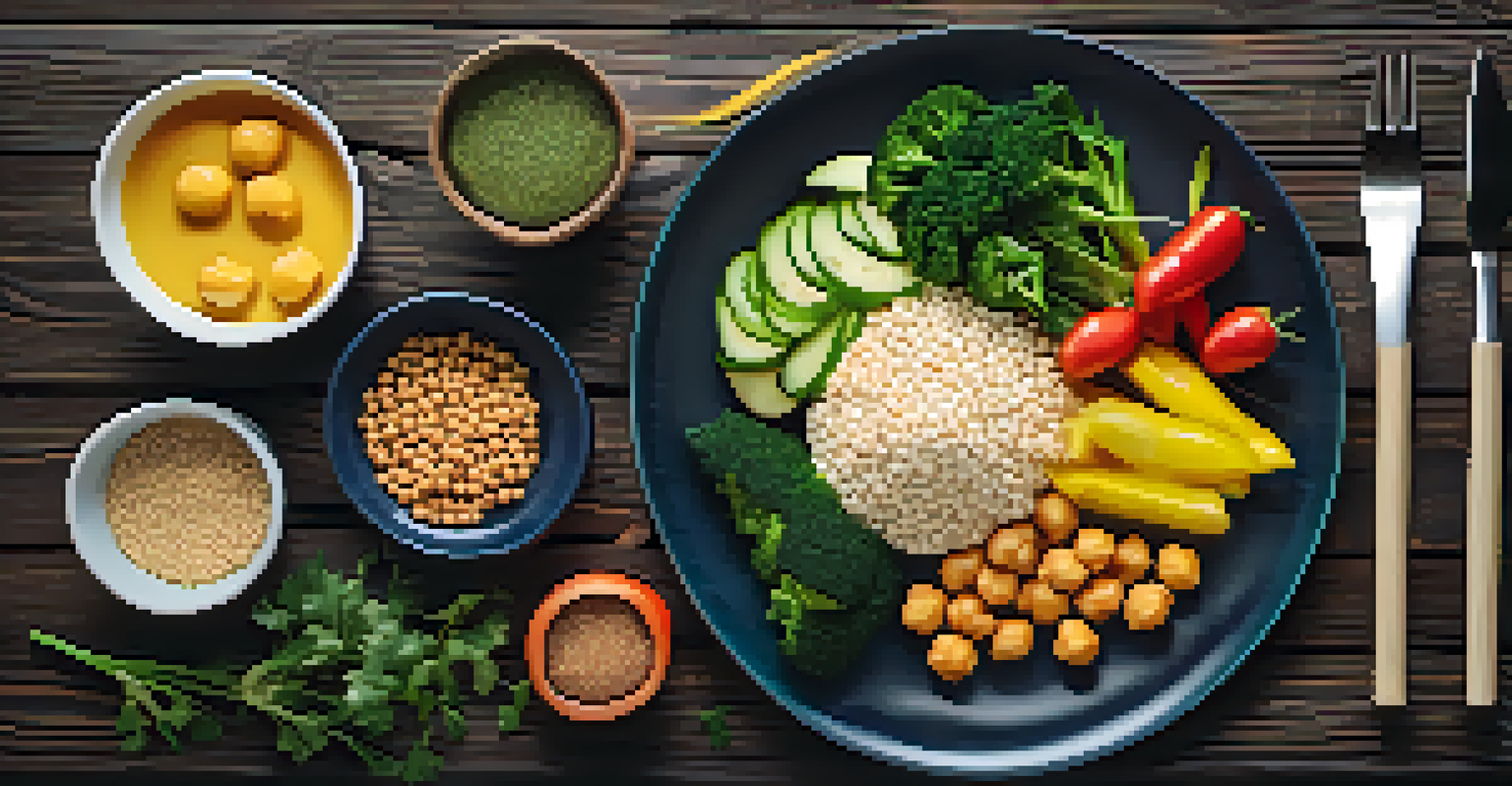How to Create a Weekly Vegetarian Meal Plan for Beginners

Understanding the Basics of Vegetarian Meal Planning
Meal planning can seem daunting at first, especially if you're new to vegetarianism. However, it’s simply a way to ensure you have balanced meals throughout the week. Think of it as creating a roadmap for your meals, which can save you time and reduce stress during busy days.
Eating vegetarian is not just a diet; it’s a lifestyle choice that can lead to a healthier you and a healthier planet.
A vegetarian meal plan typically includes a variety of fruits, vegetables, grains, and plant-based proteins. This diversity not only keeps your meals interesting but also ensures you're getting all the nutrients needed for a healthy diet. Remember, the goal is to enjoy your meals while nourishing your body.
Starting with a basic understanding of what vegetarian meals consist of will set you on the right path. Once you’re familiar with the foundation, you can explore a multitude of recipes and flavors that will make meal planning enjoyable and satisfying.
Gathering Inspiration for Your Meal Plan
Finding inspiration is key to a successful meal plan. You can explore food blogs, cookbooks, and social media platforms like Instagram or Pinterest. These resources are filled with delicious vegetarian recipes that can spark your creativity and help you think outside the box.

Another great way to gather ideas is by looking at what’s in season. Seasonal vegetables not only taste better but are often more affordable. By incorporating seasonal produce, you can create vibrant meals that showcase the best flavors of the time.
Plan Balanced Vegetarian Meals
Creating a meal plan helps ensure you include a variety of proteins, healthy fats, and colorful vegetables for a nutritious diet.
Don't forget to consider your personal preferences and dietary restrictions too. Make a list of your favorite foods and any new ingredients you'd like to try. This will help you create a meal plan that excites your taste buds and suits your lifestyle.
Creating a Balanced Meal Plan Framework
When designing your meal plan, aim for balance. A good rule of thumb is to include a source of protein, healthy fats, and plenty of colorful vegetables in each meal. This not only enhances the nutritional value but also makes your meals visually appealing.
The way you eat is a reflection of the way you live. Embrace a variety of foods to nourish your body and your soul.
Consider using the plate method: fill half your plate with vegetables, a quarter with whole grains, and a quarter with a protein source. This simple visual guide can help you create meals that are satisfying and well-rounded.
Don’t forget about snacks! Healthy snacks can help keep your energy levels up throughout the day. Think of fruits, nuts, or yogurt as great options to include in your meal planning.
Planning for Breakfast, Lunch, and Dinner
Breakfast is often considered the most important meal of the day, so start there. Simple vegetarian options include oatmeal topped with fruit, smoothies, or avocado toast with whole grain bread. These meals are not only quick to prepare but also packed with nutrients.
For lunch and dinner, think about making larger batches of meals that can be enjoyed over a few days. Dishes like vegetable stir-fries, soups, or grain bowls can be easily customized and stored. This not only saves time but also helps reduce food waste.
Find Meal Inspiration Online
Exploring food blogs and seasonal produce can spark creativity and help you develop exciting vegetarian recipes.
Lastly, be flexible with your meals! If you find a recipe you love, don’t hesitate to incorporate it into your plan multiple times. Repeating favorite meals can help streamline your grocery shopping and cooking process.
Shopping Smart: Making Your Grocery List
Once your meal plan is in place, it's time to hit the grocery store. Start by making a detailed shopping list based on your plan. This helps you avoid impulse purchases and ensures you have everything you need for the week ahead.
Organize your list by sections of the grocery store, such as produce, grains, and canned goods. This can save you time while shopping and reduce the chances of forgetting items. Plus, it can make the experience less overwhelming.
Consider buying in bulk for items you use frequently, like grains and legumes. Not only can this save money, but it also reduces packaging waste, which is great for the environment.
Meal Prep: Making Cooking Easier
Meal prepping can be a game-changer for busy weeks. Set aside a few hours on the weekend to chop vegetables, cook grains, and portion out meals. This way, when it's time to eat, you can simply grab what you need and heat it up.
Batch cooking is another effective strategy. Prepare larger quantities of a dish and store it in the fridge or freezer. This ensures you always have a healthy meal ready to go, making it easier to stick to your vegetarian plan.
Meal Prep for Convenience
Setting aside time for meal prep and batch cooking makes healthy eating easier and reduces stress during busy weeks.
Don’t forget to label your containers with dates! This helps you keep track of freshness and makes it easier to use older meals first.
Staying Flexible: Adapting Your Plan as Needed
While having a meal plan is helpful, it's essential to remain flexible. Life can be unpredictable, and sometimes you may need to adjust your meals based on schedule changes or unexpected cravings. Embrace this flexibility as part of the process.
If you find yourself with leftover ingredients, get creative! Use those ingredients in a new recipe or transform them into a different meal. This not only minimizes waste but also encourages culinary experimentation.

Remember, the ultimate goal of a meal plan is to make your life easier and more enjoyable. Don't stress if things don’t go perfectly—just keep experimenting and find what works best for you.